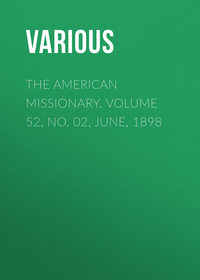 полная версия
полная версияAppletons' Popular Science Monthly, March 1899
16. The diminution of the herd is yet far from a stage which involves or threatens the actual extermination of the species, so long as it is protected in its haunts on land. It is not possible during the continuation of the conservative methods at present in force upon the islands, with the further safeguard of the protected zone at sea, that any pelagic killing should accomplish this final end. There is evidence, however, that in its present condition the herd yields an inconsiderable return either to the lessees of the islands or to the owners of the pelagic fleet.
The statements of this concluding paragraph must be taken in close connection, and the "ifs" must be carefully noted if they are not to prove very misleading. The opening sentence refers to the biologic extinction of the herd as contrasted with its commercial ruin. The former is as yet far off, the latter is a matter of history, as is admitted in the concluding statement – "an inconsiderable return." This means simply that the herd has ceased to be a commercial factor, and henceforth under present conditions sealing, whether on land or at sea, must be conducted at a loss.
This has an important bearing upon the suggested impossibility of bringing about the extinction of the species. It all depends upon whether present conditions are maintained. The breeding islands and the sixty-mile protected zone must be guarded. It cost the United States $175,000 for patrol in 1896. England's expense was less, but still considerable. It is beyond reason that this expensive protection should be continued at a loss or without hope of ultimate restoration of the herd. Remove the protection for a single season and the herd would be practically exterminated. A scattered remnant would doubtless escape to maintain a melancholy equilibrium, or perhaps to recuperate and again attract the cupidity of some adventurous sealing captain, but the herd as such would be at an end.
Stated without reference to diplomatic necessities, this concluding paragraph admits two important things: first, that the herd of fur seals resorting to the Pribilof Islands is commercially ruined; second, that its extinction as a species only awaits the abandonment of certain arduous and costly measures of protection now maintained solely in the hope of more adequate protection and the ultimate restoration of the herd.
Such was the work of the Conference of Fur-Seal Experts of 1897. The handwriting of diplomacy is mingled with that of science in its findings, but the resulting obscurity affects only minor matters. The important issues of the vexatious Bering Sea controversy are squarely met and finally settled. It is needless to say that there no longer exists a fur-seal question. It is merely a question of how to get rid of the destructive agency of pelagic sealing. This is a matter for diplomacy to adjust. Any odium which may have attached to the "man of science" as a result of the failure of the meeting of 1892 is effectually wiped out, and if the lesson is read aright by the nations, henceforth the scientific expert must be counted an essential factor in the settlement of governmental disputes.
In a paper on the industrial applications of electro-chemistry, Mr. Thomas Ewan points out as among those that may yet be developed, that it is possible, by compressing sulphur dioxide and air into separate carbon tubes dipping in sulphuric acid, to cause the two gases to combine to form sulphuric acid, and at the same time furnish an electric current. "The alluring prospect," he says, "of obtaining electric energy as a by-product in a chemical works should be a sufficient incentive to efforts to overcome the numerous difficulties in the way."
A SCHOOL FOR THE STUDY OF LIFE UNDER THE SEA
(Naples Aquarium.)By ELEANOR HODGEN PATTERSONTo go deep down under the sea, in the warm waters of the south, where exist not only the varieties of fish with which we are familiar, but thousands of jewel-like forms of animal life never seen by us, has hitherto been impossible to any but the boldest fishermen and divers. But of late years in the small aquarium at Naples the sea has been brought up, so to speak, upon the earth for us to see these strange creatures as they exist in their homes under the water, as they eat their food, as they love and hate, and prey upon each other.
Small as the collection at first seems to be, there is no zoölogical station in the world to compare with it. Probably there never will be again. Because of its advantageous station on the shores of the Mediterranean, where it is claimed the waters which wash Italy and Sicily yield a greater variety of sea life than even tropical waters, and also its comparative accessibility to all countries, the scholars who come here from all over the world find that they are able to study here as they can nowhere else the strange habits of the tiny animals down at the bottom of the sea.
There is no superfluous room taken up in the Naples aquarium for the fish that may be studied in aquariums elsewhere. Only the rarest, the strangest, the most curious creatures are here to be seen.
But one room of the beautiful building devoted to the zoölogical station, which stands on that street of Naples running along the sea, is shown to the public. One walks into it from the level of the street, and the transition from the light outside to strange semi-darkness is as if one were to suddenly find himself walking upon the bottom of the sea.
The light comes only from above, shining through water of many hundreds of cubic feet, on to what seems at first a garden of moving flowers behind tanks of clear glass, which seem, so complete is the illusion, not like glass at all, but water. The visitor walks along dark alleys lined on both sides with these brilliant tanks, and the beautiful sea animals are so close that it seems easy to touch them. It is like being in a narrow, dark theater with the stage all around and about, strangely illuminated, not by footlights, but by a radiance from above.
There are about thirty tanks in all, and at the very first of these glass-walled vats we stopped entranced. Behind it were piles of rocks shining in the water, and from every crevice grew what seemed brilliant flowers, but of colors so soft and waxlike that they were almost more lovely than our flowers of earth.
"Surely these deep red ones that cover the rocks to the left are a species of aster, and these are cacti, and these, yes, these reddish-brown one are chrysanthemums and nothing else."
But even as we spoke we saw the petals of first one, then another, flower wave back and forth, and in and out, with curious curling movements, as none of our flowers do, even in the most various winds, and then from above a long pole was suddenly thrust down into the water, at the end of which was stuck a piece of raw red meat about as large as a walnut.
It was the keeper come to feed his strange charges. Again and again were the bits of meat thrust down into the hearts of the sea flowers, and then we discovered with a kind of shock that these asters and cacti and chrysanthemums were not flowers at all, but flesh-eating animals, and that each waving petal was a mouth, by which the creature sucked in the blood of the meat.
When all the juice had been extracted from the meat, the many mouths attached to each seeming flower, that had been tightly curled upon the raw flesh, now unfolded again into their petal-like positions in a circle, one over the other, and the meat, now but a tiny ball of dry pulp, slowly sank to the bottom of the tank. What the calyx was like, or whether it had any body at all, we could not see, so entirely hidden was it behind these many waving, armlike mouths.
In the next tank several sea horses were swimming merrily in and out of rocks that were covered by a growth of miniature trees. They were smaller than the tiniest hobbyhorse that has ever been seen, as small almost as the toy horses in a "Noah's ark." The resemblance of these small fish, not larger than smelts or minnows, that have come to be known as "sea horses," to real horses is in the head only. The rest of the body tapers off into the ordinary fishlike form. I wondered, as I looked at these small horses of the sea, if it was from them that the old myth of the existence of mermaids arose. "Half fish, half women" were the mermaids, but "half fish, half horses" are these fish.
They were lively little creatures, and swam in and out of the tiny forest as if they were playing a game of "tag." What a beautiful little forest it was to play in! The trees had brown trunks about the size of one's finger, and from the top a graceful, palmlike foliage branched out, but the foliage was not in greens, but deep, translucent reds, or coral pinks, or warm browns.
While I was admiring one of the little coral pink trees, one of the sea horses swam straight into its foliage, when, to my amazement, and evidently to the amazement of the sea horse also, the foliage instantly disappeared down into the tree trunk, leaving only the brown stem standing.
Aghast with surprise at the sudden revelation that this charming foliage, like the petals of the flowers in the last tank, was also a cluster of living suckers, I asked what name they were called by, and heard with disgust the answer "worms." These beautiful, curious creatures only the things we know by the loathsome word "worms!"
These sea worms, or annelids, as the scientific scholars call them, build up for themselves the brown tubes that resemble the rough stems of pines or palms, and from the top they send out their worm-like bodies in clusters, where they wave back and forth in the water, to sweep in any food that may be near, always holding themselves in readiness to withdraw into their holes at danger.
Whether the brilliant foliage of each tree was but the many tentacles of a single animal emerging from the tube, or whether it was a whole family of worms come up to the top of their home to gaze from the chimney, so to speak, we could not discover. But, strange to say, the grotesque little sea horse seemed to be trying to decide that question for himself, for, after swimming away a moment in fright at this sudden disappearance, he returned and appeared to be peeping down into the tube.
The next tank revealed even greater surprise than we had yet seen. Here in the water long white gauze ribbons were waving, as if hung from above, and so transparent that we could see quite through them, almost as if they were composed of the white of an egg. It was only by looking closely that up near the top we could see a tiny black dot, like a pinhead, in each fleecy scarf. This was the head of the animal, or its eye, or mouth, or whatever such a delicate dot might be called.
These are of the jellyfish family, and have only lately been added to the aquarium. Owing to the difficulty of procuring such pulplike masses, they are extremely rare specimens, and can be seen nowhere else. Surely nothing more frail, more delicately lovely exists on land or sea, in plant or animal life, than these gauzy living sashes of the sea.
But not all the denizens of the tanks are beautiful to look upon. There is a tank near the door of entrance filled with objects so hideous that one starts away from them with horror. These are the octopi, or devilfish. Imagine the ugliest, biggest black spider that you ever saw, and enlarge it to the size of the largest turtle you ever saw, and on the end of each of the spider's legs fasten a wicked-looking mouth, and you can form some idea of how frightful an octopus can be.
Several of these monsters were writhing near the glass wall, stretching out their long, boneless arms, and sometimes fastening their suckers upon the glass in the search for food, thus unconsciously showing off the ugliness of their mouths. It was now time for the keeper to come to them in his round of feeding. He put into the tank from above a number of crabs, when suddenly the whole tank seemed filled with octopi. They had been sleeping among the dark rocks, of which they were so much the color that we had not before observed them. The poor little crabs had probably been stunned, or perhaps killed, by the keeper, for they made no resistance when the octopi fastened upon them their long suckers in a death-grasp. The octopi fought with each other over the possession of the crabs, and for some moments there was a terrible waving to and fro of black suckers fully two yards in length.
Beside this tank was another of clear water in which were some peaceful cuttlefish. The keeper, for a few coins, stirred these out of their quiet by moving his long stick after them. They swam about in fright for a moment or two, and then we saw them no more, for the clear water had suddenly become a thick black fluid. The cuttlefish had discharged their bags of ink to escape the pursuing enemy.
The upper floors of the zoölogical station are seldom shown to visitors, but these are almost more interesting than the tank room below. Here the great scholars who make a life study of these strange inhabitants of the deep have their tables; here the dredgings of the sea are brought by fishermen and divers for them to assort; here sea animals are developed by them from the egg, and even from invisible germs.
Each investigator into the strange lower world is furnished with his own aquaria, suited to the special branch he may be studying, for nearly all are interested in a special branch of zoölogy. One man has come a long distance to pursue the study of sponges, and he is furnished with a perfect garden of them, for they are brought up from this part of the Mediterranean in infinite variety.
Another student is studying the habits of mollusks, and basins and jars of these and their eggs are near him. There are divers' costumes hanging on the walls in which the savants may themselves descend to the bottom of the sea and study the inhabitants in their native houses.
There are laboratories and libraries here, adapted to the most exhaustive study, and a fleet of small boats is also kept exclusively for the use of the zoölogical station.
Fishermen constantly bring in baskets filled with what seems to be only wet rubbish, heaps of stones, and worthless bits of pulp. This is examined and assorted by trained eyes, and placed in tanks of water where siphons are constantly pouring fresh sea water, after which the rubbish is quietly left until accustomed to its new quarters. Then cautiously this rubbish begins to move, the stones stir, and the pulp opens into the beautiful colors, the plants, the gauzy scarfs, and the numerous other strange things afterward shown to the public in the aquarium below.
Along the walls of these upper rooms are jars wherein are preserved many curious denizens of the sea that have been killed by powerful chemicals, which have surprised the delicate animals before their sensitive tentacles have had time to close, thus preserving to science many rare creatures impossible to keep long in captivity.
The great cost of this establishment is maintained in several ways – by the issuing of publications and scientific papers in several languages, by the rents from the desks or tables used by the investigators, and by the unusually large price of admission demanded from the public at the aquarium entrance. In addition to this are the fees from the students who come from afar to study here. A payment of four hundred dollars each gives students the right to study in the Naples zoölogical station for ten months of the year.
SCIENCE IN EDUCATION. 40
By Sir ARCHIBALD GEIKIE, D. C. L., F. R. SWhen the history of education during the nineteenth century comes to be written, one of its most striking features will be presented by the rise and growth of science in the general educational arrangements of every civilized country. At the beginning of the century our schools and colleges were still following, with comparatively little change, the methods and subjects of tuition that had been in use from the time of the middle ages. But the extraordinary development of the physical and natural sciences, which has done so much to alter the ordinary conditions of life, has powerfully affected also our system of public instruction. The mediæval circle of studies has been widely recognized not to supply all the mental training needed in the ampler range of modern requirement. Science has, step by step, gained a footing in the strongholds of the older learning. Not without vehement struggle, however, has she been able to intrench herself there. Even now, although her ultimate victory is assured, the warfare is by no means at an end. The jealousy of the older régime and the strenuous, if sometimes blatant, belligerency of the reformers have not yet been pacified; and, from time to time, within our public schools and universities, there may still be heard the growls of opposition and the shouts of conflict. But these sounds are growing fainter. Even the most conservative don hardly ventures nowadays openly to denounce Science and all her works. Grudgingly, it may be, but yet perforce, he has to admit the teaching of modern science to a place among the subjects which the university embraces, and in which it grants degrees. In our public schools a "modern side" has been introduced, and even on the classical side an increasing share of the curriculum is devoted to oral and practical teaching in science. New colleges have been founded in the more important centers of population, for the purpose, more particularly, of enabling the community to obtain a thorough education in modern science.
The mainspring of this remarkable educational revolution has, doubtless, been the earnest conviction that the older learning was no longer adequate in the changed and changing conditions of our time; that vast new fields of knowledge, opened up by the increased study of Nature, ought to be included in any scheme of instruction intended to fit men for the struggle of modern life, and that in this newer knowledge much might be found to minister to the highest ends of education. Nevertheless, it must be admitted that utilitarian considerations have not been wholly absent from the minds of the reformers. Science has many and far-reaching practical applications. It has called into existence many new trades and professions, and has greatly modified many of those of older date. In a thousand varied ways it has come into the ordinary affairs of everyday life. Its cultivation has brought innumerable material benefits; its neglect would obviously entail many serious industrial disadvantages, and could not fail to leave us behind in the commercial progress of the nations of the globe.
So much have these considerations pressed upon the attention of the public in recent years that, besides all the other educational machinery to which I have referred, technical schools have been established in many towns for the purpose of teaching the theory as well as the practice of various arts and industries, and making artisans understand the nature of the processes with which their trades are concerned.
That this educational transformation, which has been advancing during the century, has resulted in great benefit to the community at large can hardly be denied. Besides the obvious material gains, there has been a widening of the whole range and method of our teaching; the old subjects are better, because more scientifically taught, and the new subjects enlist the attention and sympathy of large classes of pupils whom the earlier studies only languidly interested. Nevertheless, it is incumbent on those who have advocated and carried out this change to ask themselves whether it has brought with it no drawbacks. They may be sure that no such extensive reform could possibly be accomplished without defects appearing somewhere. And it is well to look these defects in the face and, as far as may be possible, remove them. In considering how I might best discharge the duty with which I have been honored of addressing the students of Mason College this evening, I have thought that it might not be inappropriate if, as a representative of science, I were to venture to point out some of the drawbacks as well as the advantages of the position which science has attained in our educational system.
At the outset no impartial onlooker can fail to notice that the natural reaction against the dominance of the older learning has tended to induce an undervaluing of the benefits which that learning afforded and can still bestow. In this college, indeed, and in other institutions more specially designed for instruction in science, provision has also been made for the teaching of Latin, Greek, and the more important modern languages and literatures. But in such institutions these subjects usually hold only a subordinate place. It can hardly be denied that generally throughout the country, even although the literary side of education still maintains its pre-eminence in our public schools and universities, it is losing ground, and that every year it occupies less of the attention of students of science. The range of studies which the science examinations demand is always widening, while the academic period within which these studies must be crowded undergoes no extension. Those students, therefore, who, whether from necessity or choice, have taken their college education in science, naturally experience no little difficulty in finding time for the absolutely essential subjects required for their degrees. Well may they declare that it is hopeless for them to attempt to engage in anything more, and especially in anything that will not tell directly on their places in the final class lists. With the best will in the world, and with even, sometimes, a bent for literary pursuits, they may believe themselves compelled to devote their whole time and energies to the multifarious exactions of their science curriculum.
Such a result of our latest reformation in education may be unavoidable, but it is surely matter for regret. A training in science and scientific methods, admirable as it is in so many ways, fails to supply those humanizing influences which the older learning can so well impart. For the moral stimulus that comes from an association with all that is noblest and best in the literatures of the past, for the culture and taste that spring from prolonged contact with the highest models of literary expression, for the widening of our sympathies and the vivifying of our imagination by the study of history, the teaching of science has no equivalents.
Men who have completed their formal education with little or no help from the older learning may be pardoned should they be apt to despise such help and to believe that they can very well dispense with it in the race of life. My first earnest advice to the science students of this college is, not to entertain this belief and to refuse to act on it. Be assured that, in your future career, whatever it may be, you will find in literature a source of solace and refreshment, of strength and encouragement, such as no department of science can give you. There will come times, even to the most enthusiastic among you, when scientific work, in spite of its absorbing interest, grows to be a weariness. At such times as these you will appreciate the value of the literary culture you may have received at school or college. Cherish the literary tastes you have acquired, and devote yourselves sedulously to the further cultivation of them during such intervals of leisure as you may be able to secure.
Over and above the pleasure which communion with the best books will bring with it, two reasons of a more utilitarian kind may be given to science students why they should seek this communion. Men who have been too exclusively trained in science, or are too much absorbed in its pursuit, are not always the most agreeable members of society. They are apt to be somewhat angular and professional, contributing little that is interesting to general conversation, save when they get a chance of introducing their own science and its doings. Perhaps the greatest bore I ever met was a man of science, whose mind and training were so wholly mathematical and physical that he seemed unable to look at the simplest subject save in its physical relations, about which he would discourse till he had long exhausted the patience of the auditor whom he detained. There is no more efficacious remedy for this tendency to what is popularly known as "shop" than the breadth and culture of mind that spring from wide reading in ancient and modern literature.











